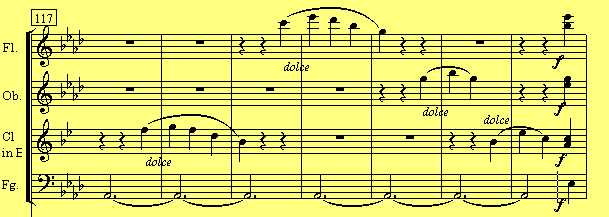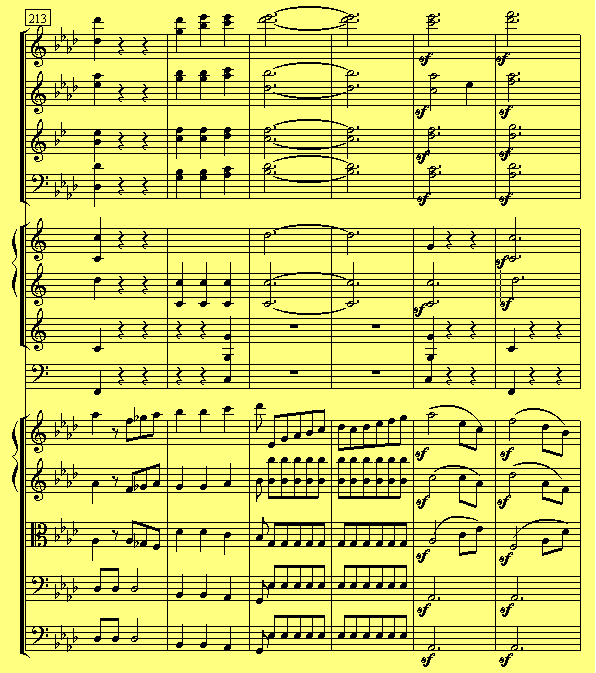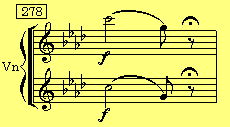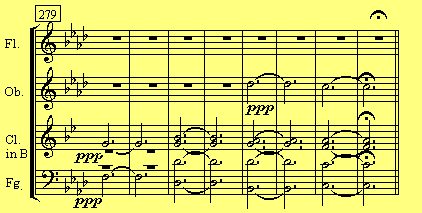
(3)
Development until the motif of beginning comes out

From bar 58, it differs from till then, there is “ff ” with downward melody. There is “an anger of governor-general” by timpani that is represented by ten times hitting of triplets, and ? of bar 69 by tutti.
If all bars and the head of the next bar of solution are
regarded as four motifs, that means “motif of fate”. But it’s
too hasty to be decisive.
? of bar 69 and of the first sound of bar 73 are the last
sounds of each bar before. From second time to next bar, it goes
on with a rush like syncopation. Double bass and violoncello lead
to “no : nicht (Gr.)!”. Bar 73 is same.
There are half notes in bar 74, and both become outcries like “resignation”.
Third time of violin and viola here in bar 74 needs attention. Phrase seems to be a unit of bar, because there is slur. But then Egmont is likely to come to realize “defeat”. He has still his last trump. It’s “voice of people” of bars 82-83 that supports him.
Therefore “otherwise : andernfalls (Gr.)” fit ♪♪ of third time, auftact of half note.
Last trump at last
The last trump comes to be cut at bar 82 at last.
People got “angry” yet like this, “I suppress them by
persuasion.” In bars 82-91.
“Well, what shall I do? I must listen to their requirements・・・.”
In bars 92-106.
Of course this last trump is voice of people at the beginning. But a look somewhat like “?” of first part with “p ” and of going slightly up of uneasy is not be seen here. It’s exactly. Melody of woodwind instrument does not continue till the end. It may be felt like “I cannot suppress anymore”.
Melody of “persuasion” is twice for two times of “voice of people”. “Anymore” is twice for third voice. The third one repeats the same melody with modulation, “Now! Now! Now! Now! Yes!” in bars 96-100.
The motif of second time of bar 100 and “sf ”, that is “Yes!”, (includes first time of next bar) repeats three times. In the fourth repeat, he triumphs “yes, I do”.
♪ in bars 104-110 are tensed high. They represent a look of governor-general that “grinds his teeth”, and they are tensed more high till just on the verge of crash.
And one more push. There appears “frankness” of Egmont to be loved, and “recollection” till then is told.
Scene of recollection
The music changes completely from bar 106. It’s gentle.
While scene of confrontation repeats, his real intention is represented simultaneously “in his heart, he thinks ・・・”. According to this part, it’s proved that Egmont is not a man of personality that to settle at a stretch by force, but a hero with gentle heart to be “loved” (though it’s fatal to him).
It is flute that sympathizes first of all with the opinion insisted by clarinet (as same as at beginning). That is Kl?rchen.

In this overture, her existence is about it. However she
certainly makes readers of this drama (hearers of this music)
feel “relieved” to this warlike political problem by her
cheerfulness and floweriness.
Therefore a little inadequate “bright and flowery” tone is
desired than “misery and sorrowful” one.
?? with “f ” are realty in contrast.
There is presentiment of coming fate from bar 145. It becomes serious. The same passage with beginning of the 2nd part repeats like to tear it away, the same way is repeated again.
Same drama with beginning
The same drama with the beginning repeats from bar 159. It’s almost same music.
Passage of upward ♪ in bars 215-216 is the only difference. But this passage notices that he is taken in by “trap of governor-general” known at “recollection”.

I mean there is same passage of upward ♪ that governor-general looks like “grinding his teeth” when Egmont was predominant over him by showing power of people. Same part appears afterward, but the meaning sounds different for this passage is here.
It is wrote very well to expect mental process (subliminal)
that remains with depth mentality of audience.
Hearers seldom notice, but effect is enough.
<Beethoven is great !>

Process until “description of guillotine”
After the second confrontation of two men, motif of “people” begins to sound suddenly by horn, clarinet and fagotto in bars 259-262.

The last trump of Egmont becomes an excuse for imprisonment
and execution of him on the contrary. He notices that and cannot
insist strong anymore.
This point is touched so, and he gives up.

This passage is that of “description of guillotine” in commentary in bar 278. There is fermata.
Therefore readers (hearers) imagine while this fermata that “Egmonto is imprisoned and is cut by his neck afterward”.
The most impressive thing in final is this passage of two tones. It jumps down and the tone below is short. Therefore if “description of guillotine” is an illusion, it may not differ from Beethoven’s essential “intention” so much.
We imagine “description of guillotine” as he wants entirely.
There was melody of “severe tone” by ? and half note
(bar 259). On the contrary, from bar 263, “downward motif” is
formed by half note and ?. The dash is suddenly weakened and in
the end the motif of this “guillotine” with “f ”
(not ff but one f ) this time once.
It makes to perform as if nothing else is more impressive.
Who has any other imaginations?
Choral of the goddess of liberty

There is a choral in bars 279-286. That is “voice of god”.
This is an important bridge part to go on to the 3rd part. If you did not read Goethe’s drama “Egmont”, it’s difficult to understand this part and the 3rd one.
In conclusion, it must be developed in these eight bars from decisive “description of guillotine” in order to sing “victory song” aloud.
Original of Goethe bears also traces of great efforts how to deal with such a close.
As real news, “Graf Egmont the hero was executed. People
raises a rebellion and the race of het
Then he enters a goddess of liberty of looking Kl?rchen to Egmont’s dream in prison before execution. He solves the difficulty by suggesting final “free independence of folkways”.
The order is opposite, so a commentator seems to conclude that the passage of “description of guillotine” just before this is wrong. But I think it may not be thought such “narrow-mindedly”.
Goethe writes in the last stage directions,
“Trommeln.
Wie er auf die Wache los und auf die Hintertür zu geht, f?llt der Vorhang: die Musik f?llt ein und schließt mit einer Siebessymphonie das Stück.”
He walks toward the guillotine firmly and being sure of victory.
Beethoven inverts this scene in overture. His organization is this order, “hero is killed”, “angel leads him to heaven”, and “his wish is realized after his death”. That is understandable very much.
Rather it should be his victory that misery close is wonderfully linked to victorious music without oddness within only eight bare.
Moreover he just only develops “Amen cadence” of progress from F to C basically. It’s splendid indeed.
This understanding may be unable without reading origin. There is no room for other interpretation.